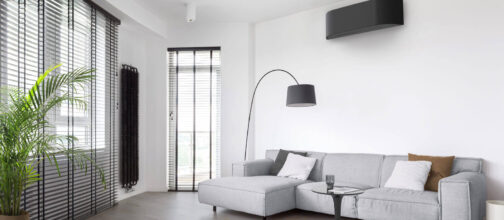Answers to frequently asked questions about solar panels
For answers to questions you may not have thought of asking, browse our FAQs.
When the sun shines on solar PV (photovoltaic) panels, they automatically generate direct current (DC) electricity. This electricity is then fed into an ‘inverter’ which transforms it into alternating current (AC) which you can use in the home or at work.
A typical 4KWp (10-12 Panels) domestic solar panel system now costs in the region of £5,000 to £7,000 including VAT.
Commercial solar PV systems usually start around £10,000 + VAT.
Solar panels are incredibly robust and should last at least 25 years, most likely considerably longer. They gradually degrade over time, generating a little less electricity as each year passes down to around 80% of the original capacity by the end of the 25-year period.
Each project will be supplemented with the datasheets of the materials used to know the exact manufactures testing.
It normally takes no longer than a day to install a domestic solar panel system up to around 15 panels. Smaller systems may only take half a day. If you have both solar panels and battery storage installed, the project may run over into a second day.
Larger, roof-top, commercial solar PV installations can take anywhere from a couple of days to four weeks or longer, depending on the number of panels and the type of roof covering.

Most homes consume about 30% of the electricity generated by the panels. The remaining 70% is exported to the national grid. If you install battery storage as well, you can capture about 80% of the solar electricity, with only 20% escaping to the grid.
Commercial customers usually have much higher energy needs, and solar panel systems are sized so that between 50% and 100% of the solar electricity is consumed on site.
Yes you can. If your electric car is plugged into its charging point at the same time as the sun is shining on your panels, then some of the solar electricity will flow into your car’s battery.
You can even get EV charging points that can be set to charge your car only when there is sufficient solar electricity available – guaranteed environmentally friendly motoring at zero cost.

Solar panels generally have two warranties:
First, a product warranty. This is typically 10-12 years, though can be if 25-40 years for the more expensive panels. If the panel stops working within the warranty period, it will be replaced, fixed, or you will receive financial compensation.
Second, a performance warranty. Most manufacturers guarantee their panels will operate at least 80% of their original capacity after 25 years. Some specify over 90%.
Yes. While it’s true shading from trees or chimneys will lower the electrical output of a solar panel, there are technologies available that help mitigate the effect of shading.
One of the best solutions on the market is made by SolarEdge: a power optimiser is installed on the back of each panel, making every panel’s output independent of all the other panels in the array. This increases overall solar generation considerably.
You normally generate more solar electricity than you need at any given moment. If you have battery storage put in as well, the battery keeps an eye on the solar generation, and, as soon as it sees surplus solar electricity, it starts charging itself with that surplus.
The stored solar electricity then discharges automatically when you need it. In this way, you capture and use a much higher percentage of your solar electricity and much less flows out to the national grid.

In many cases, yes. If you have a hot water cylinder with an immersion element, excess solar electricity can be automatically diverted to turn on the immersion and heat your water. A popular device to achieve this is called the Solar iBoost. It’s inexpensive to install and pays for itself very quickly.

The vast bulk of solar panels are now made in Asia by large-scale, specialist companies. Typical manufacturing countries include China, South Korea, Taiwan and Singapore. So-called ‘Tier 1’ panels are made in huge quantities and to exacting standards.
Solar PV panels generate electricity. Solar thermal panels, on the other hand, produce hot water only (not electricity). In recent years, solar thermal panels have become less attractive, as heat pumps have grown in popularity as a way of heating both your home and water.
Residential installations require a second generation (SMETS2) smart meter connected to the internet. Smart meters track any solar electricity exported to the grid at half-hourly intervals, which is required to qualify for the Smart Export Guarantee (SEG) tariff.
Solar installers (we included) do not install smart meters. You will need to request your energy provider to supply and install one. Typically, this will be done free of charge.
Typically, once you contact us and get your first quote, you should expect to get your solar system up and running in around 3-4 months. This ‘waiting window’ will give us the opportunity to reserve equipment, complete a site survey, file in your DNO application and scaffold your property so everything is in order up to your installation date.
It is recommended to conduct a structural survey in the following situations:
- If the building is an older or historic building, as these buildings may have unique structural characteristics that need to be considered.
- If the building has been altered or remodelled, as changes to the structure may have been made that could impact the stability of the solar panel system.
- If the building has been damaged in the past, such as from fire, flood, or other natural disasters, as this could impact the structural integrity of the building.
- If the building has a flat roof, as these roofs may not have the same load-bearing capacity as pitched roofs.
Generally, it will be a couple of days before and around 4 days after.
Yes, it is technically feasible to integrate a solar project with a re-tiling roof project by aligning their timing and coordination. The scaffolding work can be used for both jobs reducing the overall cost of the solar system. For in-roof installations, even greater savings can be achieved by reducing the number of tiles required.
Proper coordination between the two projects is essential to ensure that the panel installation does not interfere with the re-tiling process and vice-versa. The key milestones that are required at the installation phase of an in-roof project is when a roof has been felt and battened.
Distribution network operator (DNO) is the company responsible for managing and maintaining the electricity distribution network in a specific geographic area. The distribution network is the system of power lines, substations, and other infrastructure that delivers electricity from the transmission system to homes and businesses.
If your inverter is greater than 3.68kW per phase and/or your battery inverter is greater than 3.68kW per phase, we must request permission from your distribution network operator (DNO) before installing. They assess if the grid around your area can handle its increase in power. They have a process time of about 10-12 weeks. We handle the application process and only will require your signature on a Letter of Authority form. This ties each application to a single installer.
The reply is usually one of three:
- Accept us to install without restrictions
- Accept the install but with an export limitation device to only allow for certain export
- Would not let us install since the grid in your area will not be able to handle the power increase. They will specify to reduce the system to a certain amount in this case
As a homeowner you are obligated to seek permission where necessary from the DNO (Distribution Network Operator) when installing solar photovoltaic (PV) panels, battery storage, an EV charging point or heat pumps. These installs spell major modifications to your connection and your local DNO needs to be aware, Without the proper permissions and notifications you will not be deemed eligible for Smart Export Guarantee (SEG).
Infinity Energy will apply for permissions and post-notify installations to the DNO in accordance with their regulations, on your behalf. Although, the homeowner will be required to contact their energy supplier (i.e. Octopus) to arrange the SEG.
To help households improve energy efficiency, keep energy costs down and support the UK’s long-term Net Zero ambitions, VAT on installing energy-saving materials (ESMs) in residential premises will be 0% in the United Kingdom until 2027. In other words, you will not pay tax for your complete solar system. Retrofitting Lithium-ion batteries do not benefit from this relief unless they are installed as part of a new solar panels system.
Generally, within a day or two after the installation.
Until very recently, the majority of energy providers charged a fixed rate for electricity, with the cost for one kWh of electric energy being the same, no matter what time of day or night you use your oven or dishwasher.
However, some suppliers have introduced off-peak tariffs (or smart tariffs), meaning you will be charged less at certain times of the day when overall electricity demand is low. This can be ideal for EV owners. You can take advantage of the cheap cost and fill up your EV at night at a fraction of the fixed cost.
You can even charge up your solar battery at night to benefit from the off-peak tariff, and then use this stored energy the following day rather than pull from the grid at the daytime rates. This can be highly advantageous for solar system owners during winter when typically, solar generation is lower due to weather and short days.
All battery and inverter manufacturers typically provide a monitoring platform for their products, which can be accessed via a mobile application or a web browser. These platforms often offer real-time monitoring capabilities and other parameters of the battery and inverter.
Some advanced monitoring systems even offer per panel level monitoring, providing detailed information on the performance of each individual panel. Additionally, these platforms often include historical data analysis, allowing users to view the performance of the system over a period and to identify trends in the data.
Solar energy yield changes with each season. Typically winter months are not ideal for solar due to limited sunlight and short days, so it is expected you will rely more on the grid. Chances are there will be times where you will not fill up your battery just with solar. This is why off-peak tariffs are so great, as you can charge up your battery at night for considerably cheaper and use this energy to top up your solar in the day.
On the flip side, during summer months you are very likely to be filling up your battery and exporting to the grid, thereby reducing your bills and reliance on the grid dramatically. Those customers with solar PV and battery systems that meet or exceed their electrical demand, often find themselves “off-grid” from March to October.
Another way to counteract low winter generation is with more solar panels! This is option is dependent on you having the necessary available roof space. This will result in more electricity being exported to the grid in the summer months when generation is higher than demand.
A solar PV proposal using sophisticated software will give you an accurate idea of potential solar PV generation, help us determine the best size battery for you, and provide you with figures to help you make decisions on whether the extra investment makes sense in your case.
What is the difference between the panels that are in a string and those that have Power optimisers?
Solar panels are connected to each other in strings, these strings are then connected to an inverter. Panels belonging to the same string only perform as well as the weakest panel in the same string. So, if one panel gets shaded and its output is reduced, then it causes a ‘’bottleneck’’ for the whole string and reduces its entire output.
Performance reduction can also happen if panels within the same string have a different pitch angle, orientation, or make and model.
Inverters for domestic applications typically support two strings, allowing for two sets of panels with two different sets of parameters.
However, if for example, your system has a third set of panels with a third orientation or various panels with a unique orientation for each, then it becomes necessary to use an optimised system. Each panel would then have a power optimiser attached to it making it independent from the rest and allowing it to perform to its maximum individual capacity.
Our initial proposal attempts to incorporate all the costs required for a complete solar panel project. However, there are certain aspects of the project that can only be finalised after a site survey has been conducted. These aspects include, but are not limited to, the cost of trenching, EPS, and any difficulties in routing the cable.
A site survey is conducted to verify the information provided in the proposal such as location, shading, orientation, access, and clearances. This allows the assessment of the specific requirements of the site and to identify any potential challenges that may impact the cost of the project. Cable routing is also an important aspect of the project, as it determines the length and type of cable required to connect the solar panels to the inverter or from the inverter to your distribution box, and the cost can vary based on the distance and difficulty of the route.
It is important to note that while the proposal provides an estimate of the cost of the project, it is subject to change based on the site conditions and specific requirements of the project, as identified during the site survey.
Generally, your solar system will not operate during a shortage as any power going back to the grid is a life-threatening danger to any technicians conducting remedial works on the grid. However, some new generation inverters and batteries offer EPS functionality, which means you can isolate the household during power cuts and provide backup power.
There are a few EPS levels we can refer to:
- 13A double sockets. This is the easiest and most affordable EPS function you can add to your battery. Within seconds, the inverter will disconnect from the grid and power any small appliance such as your smartphone or torch.
- Automatic circuits/manual change over switch: Here only your most important appliances – i.e. fridge, lights – are rewired into a separate distribution board and supplied directly from the battery. These circuits will be automatically supplied from the lithium-ion storage after a short delay. This strategy cannot be utilised to power the entire house because the amount of power it can draw is limited to battery inverter back up output.
- Full House Backup. We can utilise a device such as a gateway to isolate your property during a power cut enabling the whole house back up functionality. The maximum back up amount will still be the inverter output of your battery inverter and if it does exceed it there will be a momentary shut down and restart back with heavy loads turned off. Currently, Tesla Powerwall’s 2 offer full backup functionality, with SolarEdge 3-phase full backup pending. If you are looking for a backup functionality, we would recommend the Tesla Powerwall.
No. In most cases, you will not need planning permission to install solar panels for your home.
However, certain types of properties are more likely to require planning permission for solar panel installations, including: listed buildings, flats, or properties in conservation areas.

Installing bird mesh is one of the most effective ways to pigeon proof your solar panels.

We would suggest cleaning your solar panels no more than once a year, the rainfall in the UK will be enough to clean them in the interim.
OUR  REVIEWS SPEAK FOR THEMSELVES
REVIEWS SPEAK FOR THEMSELVES
Call 0800 909 8882
for more information about solar panels, or contact us online
LATEST NEWS & GUIDES
SERVICE THAT’S FULLY SUPPORTED, ACCREDITED AND GUARANTEED














